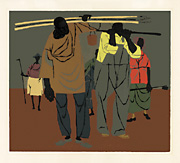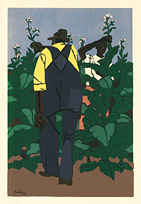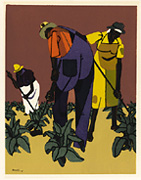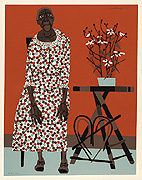The Hitchhiker - 1937, Color Serigraph.
Williams 1. Edition unknown but small. Signed in ink, in the image, lower right.
Image size 16 3/4 x 13 1/8 inches (425 x 333 mm); sheet size 21 1/2 x 17 inches (546 x 432 mm).
A fine impression, with fresh colors, on cream wove paper; full margins (1 5/8 to 2 5/8 inches). Light toning to the paper within a previous mat opening, otherwise in excellent condition. Scarce.
After the 1936 painting The Hitchhiker, one of Gwathmey's earliest surviving oil paintings; Gwathmey destroyed most of his early work in 1938. Judd Tully, a journalist who interviewed Gwathmey in 1985, confirms that the painting is autobiographical: "The shirt-sleeved figure in the foreground, with thumb to the sky, could well be the painter, heading back home to Richmond" –Hot Off the Press, Tyler & Walker, Ed., 43.
Literature: Hot Off the Press: Prints and Politics, Linda Tyler and Barry Walker, Tamarind Institute, 1994; American Screenprints: 1930s-1960s, Clifford Ackley and Shelly Langdale, Museum of Fine Arts, Boston, 1991; and Order and Enigma; American Art Between the Two Wars, Sarah Clark-Langager, Munson-Williams-Proctor Institute, 1984; Pressed In Time: American Prints 1905-1950, Henry E. Huntington Library and Art Gallery, San Marino, 2007; The American Scene: Prints from Hopper to Pollock, Stephen Coppel, The British Museum, 2008 (back cover illustration).
Exhibited: Pressed In Time: American Prints 1905-1950, The Huntington Library and Art Gallery, San Marino, 2007-2008; The American Scene: Prints from Hopper to Pollock, The British Museum, 2008.
Collections: Boston Museum of Fine Arts, British Museum, Metropolitan Museum of Art, MoMA, Munson-Williams-Proctor Institute, National Gallery of Art.
Created when the country was still in the throes of the Great Depression, the work depicts the social inequalities of the time, contrasting the plight of the hitchhikers with the lives of the affluent, promoted in the background billboards. Gwathmey's use of flat color and graphic simplification, emulating the imagery of consumerism and popular culture, predates that of the Pop-Art movement by almost 20 years.
$9000.







